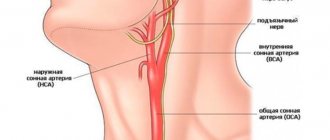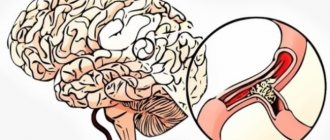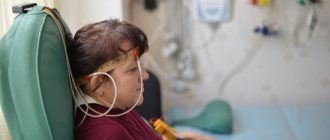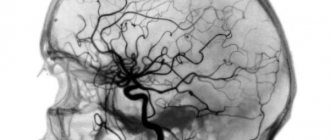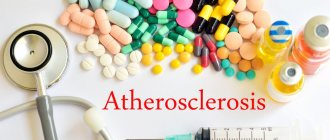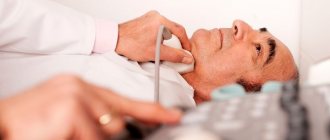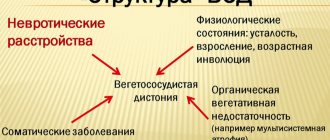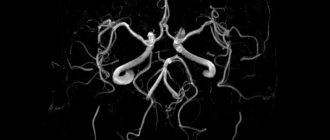The benefits of exercise for atherosclerosis
A number of factors usually lead to atherosclerosis. These include smoking, frequent hypothermia of the feet, mental trauma, constant stress and lack of sleep, poor nutrition and obesity, high blood pressure, heredity and chronic diseases. Drug treatment aims to strengthen the walls of blood vessels, expand the lumen and reduce blood clotting. If the disease is advanced or treatment does not produce positive changes, then surgical methods are prescribed.
Gymnastics for atherosclerosis of the lower extremities allows you to:
- Strengthen the body;
- Improve blood circulation, incl. and peripheral;
- Normalize the work and condition of the cardiovascular system;
- Increase muscle tone;
- Prevent vascular spasms;
- Normalize metabolic processes in tissues;
- Restore mobility of joints and ligaments, muscle tissue;
- Improve general condition after reconstructive operations.
- Regularly performing a set of exercises for atherosclerosis leads to the development of collaterals - side paths of blood flow, which are responsible for ensuring the movement of blood bypassing the affected area.
Exercise affects the entire body, improving coordination, endurance, breathing and body awareness.
At stages 1 and 2 of OA, classes are divided into introductory and main parts. Introductory exercises include breathing exercises, general warm-up, walking around the room or in place. You need to perform the exercises in a well-ventilated and warm room; during exercise, keep your back straight, control your breathing and monitor your pulse.
It is important to avoid overwork and deterioration in health, but to give the body a feasible load.
The main part includes general strengthening, special and breathing exercises, which alternate with each other. Special techniques include dynamic techniques aimed at tensing and relaxing muscle fibers and changing the position of the affected limb. When performing the complex, if necessary, adhere to the given sequence, train the large muscles first, and only then the small ones. At the end of the cycle, to strengthen the arteries of the lower extremities and relax, perform several light exercises from classical yoga and to normalize breathing.
A complicated disease requires only gentle exercises, slow walks, swimming, special water aerobics and yoga. Contraindications for exercise therapy are gangrene, migrating thrombophlebitis, acute thrombosis.
Classes are not carried out in case of general weakness, elevated body temperature and severe migraines.
Therapeutic exercise for atherosclerosis of the blood vessels of the heart and brain
Published by Rico on Sun, 01/02/2009 - 01:22
The physical exercises I want to talk about train the heart, blood vessels, lungs, muscles, normalize metabolism, they are a natural biological stimulant that mobilizes the body's adaptive mechanisms.
Systematic training improves blood circulation in the heart and central nervous system, increases not only arterial but also venous blood flow: the heart and brain are better saturated with oxygen, and metabolic end products are removed from them faster.
Classic exercises
From a standing position
Classes begin with a short and calm warm-up and stretching. Patients with heart disease and diabetes should not use weights or make sudden and rapid movements. During gymnastics, pay attention to the pulse, internal sensations and well-being. The first workouts should take place with minimal stress and cause only slight fatigue. Loads are dosed depending on age, external chronic processes and health status.
Exercises for atherosclerosis of the vessels of the lower extremities in a standing position begin with walking.
After a few minutes they begin:
- Slow squats. They are performed from a standing position holding onto a special support or the back of a chair. Do not lift your feet off the floor, but you can raise your heels to increase the complexity of the exercise. The depth of the squat increases gradually;
- The left foot is placed on the toe and the body weight is smoothly transferred to it. Then do this movement for the right leg. To make it easier, you can grab a chair or any support. Repeat the exercise 8 times;
- Walking. You can walk in place or around the room, raising your legs high. Execution time - 2-3 minutes;
- Place your hands on your lower back. Smoothly and without jerking, bend your right leg and make several circular movements, describing the largest possible circle. Then do the exercise with the other leg 4 times. For each limb, do 8 to 10 repetitions;
- Raising legs one at a time to maximum height;
- Tilts. Place your legs wider than your shoulders. Slowly move your body forward, reaching the floor with your fingertips. Tilts and turns of the body are performed with straight legs and back
- Bend and stretch. Get on your knees, take a few breaths and slide your hands forward along the floor. The body stretches behind the fingers, aiming the chest towards the floor. Try to touch the floor with your forehead by lengthening your back.
- The complex is completed by walking on the heels, smooth turns of the body and breathing exercises. If a certain number of repetitions is not specified, then do each exercise 10-12 times.
From a supine position
To perform gymnastics you will need a yoga or gymnastics mat. You need to lie on your back, stretch and relax your legs, and spread your arms to the sides so that they form a straight line with your shoulder. Inhale - the left leg bends at the knee joint. The foot slides slowly and steadily along the floor. The next inhalation is a smooth lifting of the leg. Grasp the knee with your hands and pull it towards the body: it should aim towards the chest and chin. Inhale for a few seconds, then release your knee. After relaxation and restoration of breathing, repeat for the other side.
To relax, take several deep breathing cycles, during which you concentrate on the air filling your lungs. Raise your legs and imitate the rotation of bicycle pedals. After this, one is raised above the floor by 15-25 cm and held for two or three respiratory cycles. Repeat for the other limb and only then relax for rest.
To improve the circulation of body fluids and warm up muscle tissue, you can shake your arms and legs a little.
Then stretch your legs: keep the muscles tense, the back surface pressed tightly to the floor. Hold for 10 seconds and relax.
Place your hands, palms up, under your head. Slowly and smoothly raise your legs at an angle of 45° to the floor, hold for about 5 seconds. Relax. Press your lower back to the floor and try to lift your body. Maintain the maximum possible time with muscle tension. All exercises from the starting position on the back for atherosclerosis of the lower extremities are performed 8-10 times. The complex is completed with relaxation and a little breathing exercises.
From a sitting position
It is more convenient to perform this complex on a chair with a backrest. Relax. As you slowly inhale, raise your arms to the sides, and as you exhale, lower them along your body. Shake your brushes. Repeat 5 to 7 times. Place your palms on your shoulders, bend your arms at the elbow joint and make 10-14 circular movements back and forth. During the exercise, the palms do not come off tightly pressed to the shoulders, the abdominal muscles are tense, the back remains straight, and the shoulder blades are brought together.
Move to the edge of the chair and raise your legs high to imitate walking. Take up to 50 steps in the air. Then slowly stand up and sit down without using your hands, keeping your back straight. Depending on your pulse and how you feel, do from 4 to 25 repetitions.
Sit facing the back of the chair, straighten your legs (they should be parallel to the floor) and while inhaling, reach with your right hand towards your right leg. Try to keep your back straight and perform the movement through lateral stretching. Exhale and relax. Repeat for each side about 6 times.
The following exercises are performed while sitting on the floor. Spread your legs to their maximum width. Move your body forward so that your elbows are free and light on the floor, and you feel muscle tension in your back. The legs remain straight, the back surface is pressed tightly to the floor. Hold for a few seconds and relax. In the starting position, restore breathing. Repeat up to 10 times. Slowly lean back, stretching your legs, to a lying position. Then rise: the head goes up first, then the shoulders, shoulder blades, middle back and lower back. You can make the exercise easier by focusing on your hands. Repeat 5-7 times.
From a prone position
A set of exercises is performed to improve blood circulation and restore mobility of the spine and limbs. Start by bending your knees. They try to reach the buttocks with their heels. Hips pressed firmly to the floor. Repeat up to 10 times. Bend your knees at a right angle and hold in this position for up to 15 seconds.
To make it more difficult and increase the load on the abs, perform this exercise with both legs at the same time. Then slowly raise your head and shoulders. The back of the head stretches back. For relief, emphasis is placed on the palms pressed to the floor. The back bends. Perform 5-6 times. Place your palms at shoulder level. Breathing is voluntary. Raise your legs one at a time so that the knee remains tense and the toe is pulled forward.
Therapeutic exercise for diabetes mellitus
Read in the article:
Therapeutic exercise for diabetes helps compensate for the disease
Therapeutic exercise (physical therapy) for diabetes mellitus, in combination with other important elements of treatment (insulin therapy, medications, diet and self-control), plays a vital role in compensating for the disease and has a beneficial effect on the patient, helping to maintain good health and performance.
The role of physical therapy in diabetes mellitus^
Therapeutic exercise for diabetes mellitus (DM) is designed to:
- activate and normalize impaired carbohydrate, fat and protein metabolism in order to prevent the occurrence of such life-threatening complications of diabetes as hypoglycemic shock and diabetic coma,
- and also stop the development of concomitant diseases (hypertension, atherosclerosis, pustular skin lesions, kidney disease, gangrene of the lower extremities, infections and others).
Due to disturbances in protein and fat metabolism, toxic substances accumulate in the body and poisoning occurs with the products of incomplete combustion of fats. In addition, a violation of fat metabolism leads to the fact that the blood is filled with fat, and the level of bad cholesterol increases. as a result, the risk of developing atherosclerosis and other cardiovascular diseases increases many times over.
Therapeutic exercise is indicated not only for all types of diabetes mellitus (except for patients who are exhausted due to untreated or poorly treated diabetes), but also for prediabetic conditions. Modern research proves that if you strictly adhere to the prescribed diet. Exercise therapy and give up bad habits - overeating, smoking and alcohol, then the transition from prediabetes to diabetes can be avoided.
According to currently available data, overeating most often contributes to the occurrence and development of diabetes mellitus. That is why people who are prone to obesity and have metabolic disorders must understand that as soon as carbohydrate metabolism is involved in the painful metabolic process, diabetes will inevitably develop.
In this regard, people with excess body weight, being at risk of diabetes, should be periodically examined for the presence of sugar in the blood and urine in order to detect the first symptoms of the disease in time and begin treatment.
In addition to excess weight, you should pay attention to the following common symptoms of incipient diabetes:
- prolonged non-healing of wounds,
- untreatable furunculosis,
- skin itching,
- bleeding gums,
- loosening of teeth,
- sexual weakness.
Features of physical therapy for diabetes mellitus ^
The main tasks of exercise therapy for diabetes mellitus:
- improvement of the cardiovascular and respiratory systems;
- improving patient performance;
- reducing hyperglycemia in insulin-independent patients (type 2 DM) and enhancing the action of insulin in insulin-dependent patients (type 1 DM);
- counteracting the development of micro- and macroangiopathies.
In diabetes mellitus, in addition to insulin deficiency, oxidative processes in the muscles are disrupted, which is why they cannot utilize glucose. During physical activity, the oxidative activity of enzymes increases significantly, alkaline reserves in the blood increase, which increases the absorption and consumption of sugar by muscles, reduces hyperglycemia and increases the body's tolerance to carbohydrates.
In addition, physical exercise in combination with insulin therapy enhances the therapeutic effect of insulin, strengthens the patient’s nervous and cardiovascular system, increases the body’s resistance and prevents the development of atherosclerosis.
A distinctive feature of exercise therapy for diabetes mellitus is that the recommended exercises should be performed at a moderate (slow) pace, as well as with muscle effort. At the same time, not anaerobic, but oxidative processes occur in the body, which contribute to an increase in glucose consumption by the muscles.
- It is recommended to start practicing therapeutic exercises with basic exercises for the muscles of the legs, arms and torso without weights, combined with breathing exercises.
- In the future, you can include weight and resistance exercises using dumbbells or expanders.
- In addition to exercise therapy, dosed walking, rowing, cycling, swimming, skiing, gardening, and light physical labor are useful.
When engaging in physical therapy, you need to carefully monitor your well-being:
- If after exercise you feel weak or tired, the load should be reduced.
- If your hands begin to tremble during training, a feeling of hunger and severe weakness appear, you need to eat 1-2 pieces of sugar and stop exercising immediately.
- You can resume training only the next day after the symptoms of hypoglycemia disappear, while reducing the dosage.
- For patients with diabetes mellitus who are on insulin therapy, it is recommended to reduce the dose of insulin on days of long and intense physical activity (after consultation with the attending physician).
Exercise therapy classes should be carried out in a well-ventilated room or in the open air, breathing should be free and rhythmic, through the nose, and exhalation should be longer than inhalation. Physical exercises must be alternated for different muscle groups and performed with a large amplitude in the joints.
You need to repeat each exercise 5-6 times; in the future, as you become more trained, you can increase the load by shortening pauses, increasing the tempo and number of repetitions. Age is not an obstacle to physical therapy; the only control is the patient’s well-being and changes in hyperglycemia and weight.
Since the patient’s blood sugar level rises after a night’s sleep (which is partly explained by the sleeper’s rest), gymnastics, walking and light physical activity in the morning are most useful, as they not only lower glucose levels, but also promote the release of insulin in greater quantities, which works most effectively at this time.
But, if possible, try to exercise in the evening (1.5 - 2 hours before bedtime) to provide yourself with equivalent physical activity during the day.
Complex of therapeutic exercises for diabetes mellitus ^
Exercise therapy for diabetes: exercises
- Starting position – main stance. Put your leg back, raise your arms - inhale, return to the i.p. - exhale. Repeat 4-5 times.
- For 2-4 minutes, walk alternately with high hip raises, arm movements, lateral movements, and lunges. Breathe freely.
- Stand straight, hands behind your head, elbows in front of your face. On the count of 1-2, spread to the sides, inhale. On the count of 3-4, return to the starting position, tilt your head forward, and exhale.
- Feet shoulder width apart. Spread your arms to the sides, turn your torso all the way to the left, your right hand should be in front of your chest. Then turn all the way to the right (left hand in front of your chest, right hand out to the side). Lean forward towards your left leg, reaching for your toe with your right hand. Repeat on the other side.
- Starting position – arms to the sides, legs apart. Make 3 springy bends to the left (right leg bent, left hand behind your back, right hand raised).
- Swing your legs, reaching the palms of your hands together in front.
- The starting position is the main stance. Lean forward, trying to touch the floor with your palms without bending your legs. Then lower yourself to the point-up position, standing on your knees, alternately moving your legs back and take the position while lying down. Without bending your arms and legs or moving them, raise your pelvis higher by leaning forward, lower your head between your hands. Lower your pelvis into a lying position. Then, alternately moving your legs forward, stand on your knees, lift your pelvis, straighten your legs and arms.
- Sitting, point your fingers back. Bend over while lying behind. Without moving your heels and arms, sit at the heels of your bent legs, then, without lifting your hands from the floor, straighten your legs and place them apart. Connect and bend your legs, then straighten (without moving your heels) and return to the starting position. Repeat 6-8 times.
- Lie on your back, bend your arms across your chest (forearms parallel to one another). Raise them without straightening or separating them (inhale) and lower them back into place (exhale).
- Lie on your stomach with your palms under your shoulders. Spread your arms to the sides (place your palms on the floor), bend your legs back, then straighten them and bend over, lifting your straight legs and arms off the floor, moving your head back. Stay in this position for a few seconds, open and close your legs again, and return to the starting position.
- Lie on your back, raise your legs vertically. On the count of 1-2, spread and bring your legs together, on the count of 3-4, bend and straighten. Repeat 4-6 times without holding your breath.
- Starting position – main stance. Raise your hands to your shoulders (inhale), then relax them, lowering your head and rounding your shoulders.
- Walk calmly for 2 minutes.
Charging using sports equipment
You can exercise to improve health and improve the condition of blood vessels using special exercise machines, fitballs, etc. The duration of the training depends on the individual condition, and the intensity of the course is selected by the attending physician.
Exercises for atherosclerosis of the vessels of the lower extremities on an exercise bike and treadmill are effective, and at the initial stage of the disease can replace drug therapy.
Daily exercise improves blood circulation, strengthens the cardiovascular system, improves metabolic processes and stabilizes the level of LDL in the blood.
Rules for exercising on an exercise bike
Exercises on the simulator will be more effective if you follow simple rules:
- Select the height of the saddle so that in the lower position of the pedals the legs remain straight or are slightly bent;
- The time of the first workout is limited to 5-6 minutes, and each subsequent workout is increased by 2 minutes;
- Pedal speed increases and decreases evenly;
- Exercise on an exercise bike is prohibited immediately after meals and on an empty stomach. After a meal you need to squeeze for at least 2 hours.
Before and after training, it is advisable to walk for a few minutes, breathing calmly and deeply.
During exercise, you need to monitor your pulse and sensations: at the first attacks of pain or rapid heartbeat, stop training.
Rules for exercising on a treadmill
Slow running and walking are designed to train blood vessels and the heart. For people suffering from atherosclerosis, recommendations have been developed for exercising on a treadmill:
- During the exercise, keep your body straight, bring your shoulder blades together, do not slouch and watch your posture;
- To make work easier and safer, you can hold on to the handrails;
- You need to start and finish with a slow and wide step.
Cardio training or vascular training for atherosclerosis is carried out 3-4 times a week, and its initial duration does not exceed 10 minutes. Gradually the running speed and duration increase.
Therapeutic walking for atherosclerosis of the lower extremities is no less useful than exercising on a simulator.
During walks, the functioning of the respiratory system and heart improves, the body is saturated with oxygen, and the central nervous system relaxes. Regular walks promote rapid weight loss, improve sleep and overall well-being, and eliminate pain.
How to choose the right exercises
When a phlebologist conducts diagnostic methods to identify atherosclerosis, the patient is prescribed treatment. If the disease is at an early stage, there are chances to correct the situation. If the disease has reached an advanced stage, surgical intervention will have to be used. Let's consider exercises recognized as aids to massage:
- An active lifestyle is considered to help blood circulation. Any type of walking will help restore normal blood flow. If a person is overweight, constant walking and diet will help get rid of extra pounds.
- Exercises are carried out in water. For example, if a person goes in for swimming, there is a way to improve blood circulation in the veins, while at the same time the muscles and blood vessels of the lower extremities are significantly strengthened.
- Alternating walking on your heels and toes makes the blood move faster through the veins; the exercises are beneficial for the blood vessels of the legs.
- It is acceptable to use squats; you will be able to strengthen the muscles from the hip to the foot, but such exercises should be performed exclusively on the recommendations of a doctor. It is important that the foot does not leave the floor during the exercise.
Additionally, a complex of physiotherapy, or exercise therapy, is used during treatment. For the lower extremities, massage is required to prevent venous diseases. If you carefully follow the recommendations, you will soon be able to get rid of the disease.
Yoga and atherosclerosis
Eastern practices for understanding your body in case of atherosclerosis are recommended for treatment and subsequent prevention. Yoga improves the condition of blood vessels, activates metabolic processes at the cellular level, helps improve mood and reduce weight. For patients, simple asanas are selected that are aimed at warming up the muscles, improving the movement of biological fluids and increasing the elasticity of tissues:
- From a standing position - legs together. Raise yourself on your toes while taking a deep breath. Raise your arms over your sides and stretch your fingers upward. Feel how your back is stretched due to the spine, exhale;
- Move the body forward. While bending over, try to reach the floor with your fingers. In a more complicated version, the palm is placed on the floor. Hold for a few seconds and, as you exhale, straighten up;
- Bend over and, as you exhale, take your left leg back. The right leg moves forward, making a lunge.
- The knee is at right angles to the floor. Keep your back straight. Hold for up to 20 seconds and repeat for the other diagonal.
Each exercise is repeated 6 to 8 times. If you have experience in yoga and are physically fit, you can perform any of the asanas.
The only exceptions are inverted ones: in case of atherosclerosis they are prohibited.
Briefly about the disease
Before talking about the benefits of massages for varicose veins, it is necessary to at least briefly understand what kind of disease it is. In simple terms, varicose veins are a pathological process that affects veins and leads to deformation of these vessels.
Deformation means expansion of the lumen of the vein, its lengthening, and thinning of the vascular walls. All this leads to the fact that blood circulates worse in the vascular bed and stagnates. The process is aggravated by the development of insufficiency of venous valves, the main task of which is to simplify the transport of blood to the heart; in simple terms, valves help lift blood, overcoming gravity.
In most cases, varicose veins affect the vessels of the lower extremities, but there are exceptions when varicose veins of the pelvis in women or in the penile area in men are diagnosed. The main goals of treatment in all cases are to strengthen the vascular walls, improve blood circulation in the vascular bed by thinning it and preventing thrombosis, and maintaining blood vessels and muscles in tone.
Massages are applicable mainly in cases when it comes to treating varicose veins in the legs.
Partner advertising
Breathing exercises for the treatment of atherosclerosis
Exercises for developing breathing can be performed as a separate complex or during gymnastics classes. They reduce the level of tissue ischemia, eliminate the manifestations of the disease and lower blood pressure, and have a calming effect on the central nervous system. Contraindications to practice:
- Osteochondrosis;
- Radiculitis;
- GB grade 3 or 4;
- Bronchial asthma;
- Chronic obstructive pulmonary disease;
- Thrombophlebitis.
Gymnastics are always performed from a standing position. Raise your arms to the sides and stretch upward. At the same time they rise up, trying to stretch their back behind their fingers. Hold for 5-7 seconds, relax. Repeat the procedure up to 10 times. With your right nostril closed with your fingers, take a deep breath in with your left. Hold your breath for a few seconds and change sides: exhale through the right nostril, and the left one is pinched. Repeat for each diagonal 11-13 times. Inhale slowly through your nose, hold your breath and exhale noisily through your mouth until you feel a vacuum in your lungs.
Next, do an exercise to saturate the organs with oxygen:
- The palm is placed on the stomach;
- Take a slow breath through your mouth, watching your palm rise. You need to take in as much air as possible;
- Without delay, exhale for a similar duration.
Then you need to move your body forward, reaching your fingertips to the floor. Exhale and stand in this position for several seconds. You need to relax your neck, shoulders and arms, and place your feet shoulder-width apart. Breathe evenly. The first respiratory cycle is performed only by the chest. The second - with the sternum and stomach, the third - only with the stomach. Then alternate breathing cycles, doing 4-7 repetitions for each.
You can perform this exercise in another way: place your feet slightly wider than your shoulders, take a deep breath and bend over. The arms hang freely, the back is rounded and relaxed. Inhale - return to the starting position. Exhalation. During rest after exercise, breathing is voluntary.
For quick and greater effectiveness, it is recommended to do at least 100 breathing exercises per day.
Gymnastics for brain vessels
To reduce the risk of spasms, it is necessary to include exercises to strengthen blood vessels into the exercise routine. Moving the head in different directions, rotating the body, standing on the head, elbows and shoulder blades, lifting the legs in a lying position, as well as somersaults and circular rotations are effective.
Standing on one leg, as well as on two, will help activate cerebral circulation. Walking will improve blood circulation, increase vascular tone and provide the brain with oxygen. Exercise dilates arteries and increases blood flow to the brain.
The following exercises will help expand the arteries and improve blood flow in the brain:
- Rotate your head first clockwise and then in the opposite direction for 2-3 minutes.
- Raising your hands, you need to make a “lock”. Bend forward, simulating chopping wood. Repeat 8 times.
- Take turns swinging your legs: the leg should move towards the opposite hand.
- Bend your knees slightly and spread your arms to the sides, make asynchronous movements: make rotational movements back with your right hand, and forward with your left and vice versa. Exercise will help improve memory, attention and concentration, as well as increase the speed of thinking.
- Perform straight leg raises, using your hands to support your lower back. At the end, stay in the “Berezki” stance for 5 minutes.
To perform the first 4 exercises, you need to stand with your feet shoulder-width apart. The fifth exercise is done lying on your back with your arms extended along your body.
Bends of the torso have an effective effect on the blood vessels of the brain.
Massage for atherosclerosis of the lower extremities
During massage for atherosclerosis of the lower extremities, special pain-relieving ointments, oils and mixtures, emulsions and lotions are used. The duration of the session usually does not exceed 10 minutes, and the procedure can be repeated several times a day.
Self-massage begins with the foot. Foot massage for atherosclerosis is carried out with soft stroking, rubbing and kneading movements, selecting the optimal force of influence according to sensations. Intensive kneading should always come after relaxing and warming movements. Massaging should not cause pain, burning, irritation or damage the skin.
Physiotherapy for atherosclerosis of the lower extremities can be supplemented with barotherapy, various baths, laser therapy or magnetotherapy. Zalmanov baths are used with the addition of white turpentine emulsion. The course consists of 15 daily sessions with an average duration of 15 minutes. Sulfide baths are also taken daily for 12 days, and the procedure time does not exceed 10 minutes.
It is useful to combine physiotherapy with wraps: this not only improves the condition of the skin, but also has a beneficial effect on the state of the cardiovascular system, activates metabolic and regenerative processes, and promotes rapid recovery.
Treatment of atherosclerosis is always complex, and its success depends on compliance with the doctor’s instructions.
Physical education is an integral and important part of therapy, aimed at improving blood circulation in the affected limbs, strengthening the muscle corset, and restoring mobility. The entire load should be feasible and not cause fatigue, discomfort or pain. During exercise, you need to monitor your pulse and increase the intensity gradually. Another important point: all exercises must be agreed upon with the attending physician and rehabilitation specialist.
How to carry out therapy for non-obliterating disease
If, after instrumental diagnostics of blood vessels, the doctor does not prohibit massage, then you need to take into account the rules for treating atherosclerosis:
- movements can only be superficial and smooth;
- use stroking and light rubbing;
- the area in which plaques are found is not massaged;
- if the lower extremities are affected, segmental effects on the lumbar zone are prescribed;
- in case of cerebral atherosclerosis at the earliest stage, massage is prescribed to the collar area without affecting the lateral surfaces of the neck;
- If after a massage session numbness of the lower extremities or dizziness appears, then such treatment should be discontinued.
Therapy can only be carried out by a specialist with a medical education and experience working with patients suffering from vascular diseases. It is important to note that before including massage in a complex of rehabilitation measures for patients with diseases of the joints, spine, and nervous system, atherosclerosis must be excluded.
This is especially true for older people who suffer from hypertension, diabetes, obesity, metabolic syndrome, or who have had a stroke or heart attack in the past.
This precaution is necessary when high levels of cholesterol or glucose in the blood are detected, a hereditary predisposition, men over 45 years of age, women in menopause, smokers, or alcohol abusers.
In the presence of any of the above risk factors, massage can provoke an acute circulatory disorder, including with fatal consequences.
Atherosclerosis of the vessels of the head: its causes, symptoms and treatment
Have you been struggling with CHOLESTEROL for many years without success?
Head of the Institute: “You will be amazed at how easy it is to lower your cholesterol just by taking it every day...
Read more "
One of the most common and serious diseases of our time is cerebral atherosclerosis. Despite the fact that the disease is localized on the walls of blood vessels, the entire body suffers from it. Cholesterol, deposited in the vessel wall, creates so-called atherosclerotic plaques, consisting of overgrown connective tissue and fat. By blocking the lumen of the canal, they block the natural flow of blood and prevent oxygen and nutrients from reaching all parts of the brain.
As a result, blood clots form in the vessels of the brain tissue, the largest number of which accumulate in the cerebral cortex and near the basal ganglia. Thrombosis results in necrotic spots, cysts and scars on the brain tissue. Dystrophy of neurons (nerve cells) interferes with normal mental activity. Consequently, cerebral atherosclerosis is a rather dangerous progressive disease.
Most often, cholesterol plaques, colored yellow and white, affect the main and middle arteries of the brain. There are especially many of them in the places where the lateral branches depart from the arteries. In small arteries, changes rarely occur; in extreme cases, fatty spots - lipoidosis - can occur. Small capillaries are almost never affected.
Atherosclerosis of the brachiocephalic arteries (BCA)
The brachiocephalic trunk is a large vessel arising from the aorta, the branches of which supply blood to the brain. When plaques appear on the walls of the right subclavian, carotid and vertebral arteries, a diagnosis of BCA atherosclerosis is made. Its symptoms are severe dizziness that occurs when turning the head, as well as when the pressure decreases. If left untreated, atherosclerosis of the brachiocephalic arteries can cause a stroke.
Doctors distinguish two types of BCA lesions:
- Stenosing (more dangerous) atherosclerosis with plaques blocking the lumen of blood vessels.
- Non-stenotic atherosclerosis, in which the plaque increases along the length of the vessel and can only reduce blood flow.
Common causes of atherosclerosis
The pathogenesis of atherosclerosis includes a whole complex of different factors. These include:
- Excess cholesterol in the body;
- Delayed cholesterol excretion;
- Arterial hypertension;
- Age from 40 - 45 years;
- General health.
Symptoms of the disease
The clinical picture of atherosclerotic lesions of cerebral vessels appears slowly. The first symptoms are:
- Unstable emotional state;
- Depression;
- Weakening of attention;
- Dizziness and headaches;
- Decreased memory;
- Sleep disorders;
- Fainting;
- Reduced ability to work.
When examined by a specialist, the following symptoms of varying degrees of cerebral atherosclerosis are revealed, allowing one to determine the stage of development of the disease:
Stage I:
- Weak pupil reactions to bright light;
- Pathological and asymmetrical reflexes.
Stage II:
- Severe disturbances of memory and will;
- Decreased ability to work;
- Deterioration of cognitive functions;
- Micro-strokes causing paralysis and fainting.
Stage III:
- Extensive damage to brain tissue and cognitive impairment.
Is it possible to get a disability with cerebral atherosclerosis?
Atherosclerosis of the second degree significantly limits the capabilities of patients: work that requires concentration, tension and quick reaction becomes unbearable for such patients. When atherosclerosis causes extrapyramidal vibration, people are unable to perform precise and fine work. And on the basis of these restrictions, a medical and social examination assigns disability group III. To be referred for disability, you must contact your attending physician or health care facility management.
How to get rid of atherosclerosis?
The work and rest regime has a particular influence on the course of the disease and its prevention: it is necessary to eliminate stress, reduce workloads, and add additional sleep during the day. Physical therapy and training will also be beneficial. Bad habits such as smoking, gluttony and alcohol abuse, which contribute to the appearance of atherosclerosis, must be categorically stopped.
The calorie content of food should be reduced to the norm so as not to contribute to the appearance of cerebral atherosclerosis. Most animal fats must be replaced with vegetable fats. The mandatory weekly diet should include foods high in protein - meat, fish, seaweed, egg whites, fermented milk products (kefir, cottage cheese), a small amount of sour cream. You need to eat plenty of vegetables and fruits every day. And foods rich in animal fats and cholesterol must be excluded from the diet (liver, cream, fatty meats, eggs, confectionery).
Read more about diet, nutrition rules and other recommendations for the prevention of atherosclerosis at the link.
Vitamins and minerals will be a complement to proper nutrition:
- Ascorbic acid, also known as vitamin C;
- Iodine-containing preparations.
Medications
Drug treatment of cerebral atherosclerosis is prescribed exclusively by a doctor based on the results of individual tests. For those who are wondering how to treat atherosclerosis, it will be beneficial to read serious literature on the subject.
In modern Russian medicine, the most common prescriptions for the following drugs are:
- If the content of prothrombin protein in the blood and its coagulability increase, aspirin cardio or cardiomagnyl is prescribed for preventive purposes.
- To improve blood flow, it is periodically necessary to use drugs that dilate blood vessels and relieve spasms: Actovegin, Cavinton, Chimes.
- Targeted drugs in such cases are statins, but they are prescribed exclusively by a doctor after studying the lipid spectrum and constantly monitoring it while taking these drugs.
- In addition, to normalize the emotional background, sedatives are used, possibly homeopathic; for severe depressive states and sleep disturbances, antidepressants and sleeping pills are indicated. It is advisable to use medications that have an antispasmodic effect (spasmalgon) as analgesics for headaches.
Physiotherapeutic procedures, for example, hydrotherapy using oxygen, radon or carbon dioxide baths, have a good effect on the body. Holidays in sanatoriums will have a beneficial effect on your overall well-being.
Remember that only timely consultation with a doctor and a healthy lifestyle can prevent the appearance and development of atherosclerosis, a disease that fundamentally disrupts people’s lives.
Video: about the treatment of atherosclerosis, a doctor’s opinion
Step 2: after payment, ask your question in the form below ↓ Step 3: You can additionally thank the specialist with another payment for an arbitrary amount ↑
